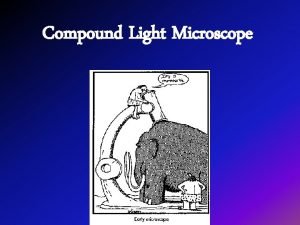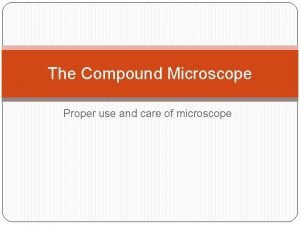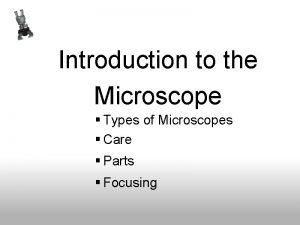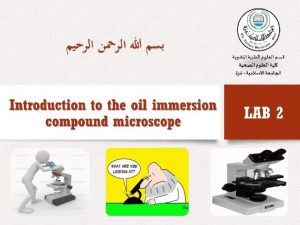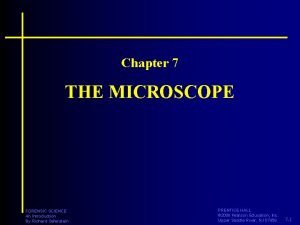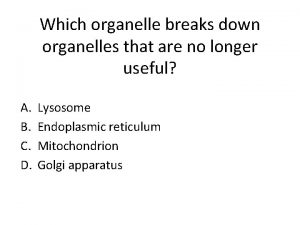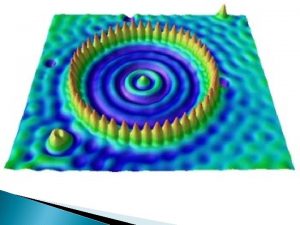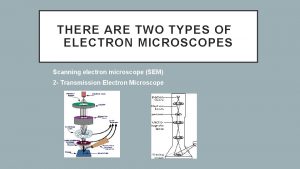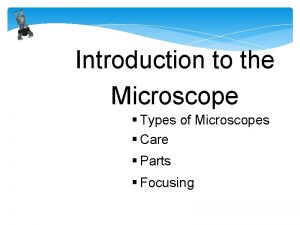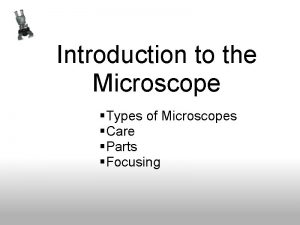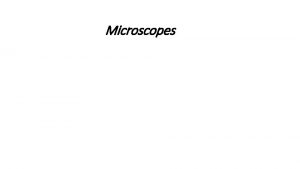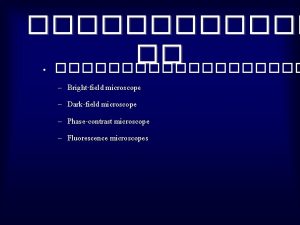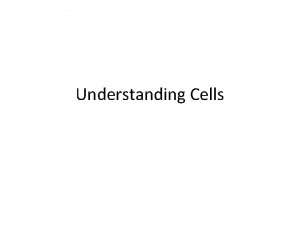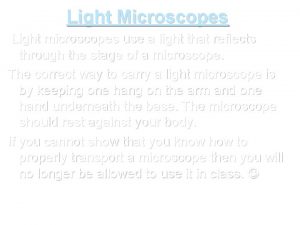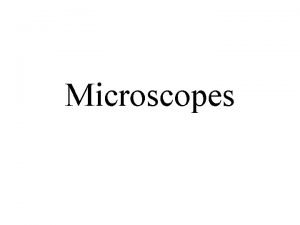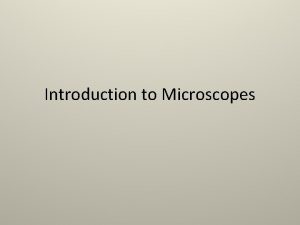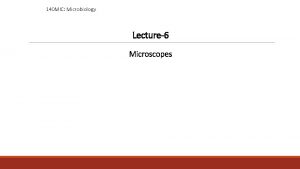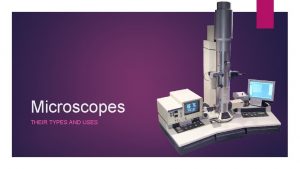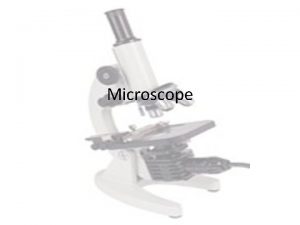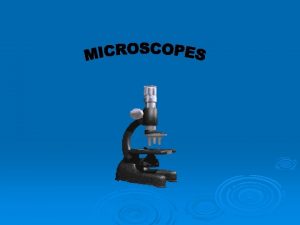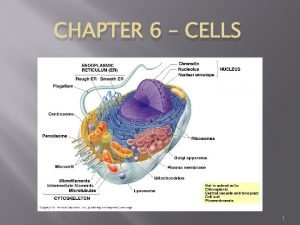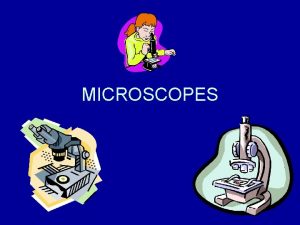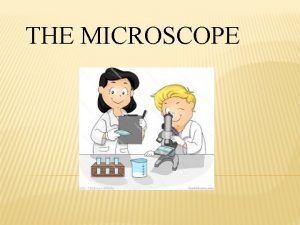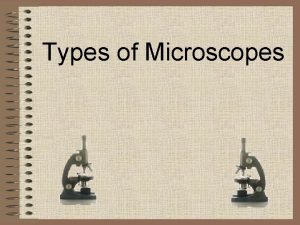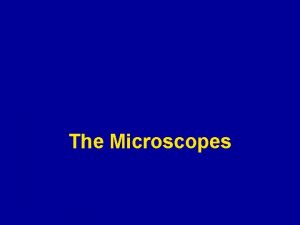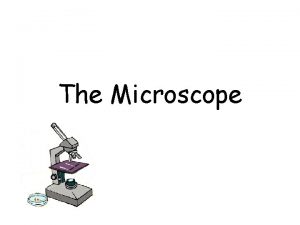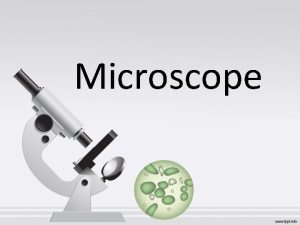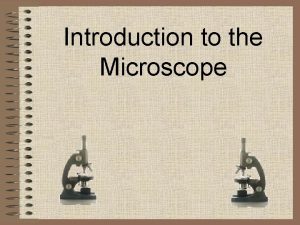Microscopes magnifications resolutions and calculations Light microscope uses
























- Slides: 24

Microscopes magnifications, resolutions and calculations

Light microscope- uses light and lenses to enlarge tiny objects

Pollen grains – light microscope

Electron microscope - electromagnetic lenses are used to direct electrons onto the tiny specimen

Pollen grains – scanning electron microscope 3 D

ABPI • http: //www. abpischools. org. uk/topic/cellbiol ogy/2

The difference between magnification and resolution. • Magnification is the degree to which the size of an image is larger than the object itself. • Resolution is the degree to which it is possible to distinguish between two objects that are very close together. The electron microscope has higher magnification and resolution

Radiolarian = single celled protozoan found in oceans part of zooplankton

Moth - eye = 800 micrometres


hydrothermal worm taken at 525 times magnification

How do we find the overall magnification of a light microscope? Eyepiece Objective lens Eyepiece Objective Magnification Overall Magnification X 10 X 4 40 X 10 100 X 10 X 40 400 X 100 1000


mm 1000 Micrometre 1000 nm

Magnification= size of image/ actual size of specimen (must be in same units)


What can we see with a microscope?

Typical sizes • • • Examples of typical sizes: 10 -100µm: cells of eukaryotes 1 -10µm: organelles 1µm: bacteria (size vary) 100 nm: viruses (size vary) 10 nm: thickness of cell membranes 2 nm: DNA molecule in human choromosome 1 nm: molecules 0. 1 nm: atoms

Nanometre Micrometre Millimetre 5 1 0. 005 0. 000005 0. 001 0. 000001 1000 1 0. 001 1 000 1000 1 3000 3 0. 007 0. 000007 500 0. 5 7 500 000

Magnification= size of image/ actual size of specimen (must be in same units)

The diagram below is a drawing of an organelle from a ciliated cell as seen with an electron microscope. Calculate the actual length of the organelle as shown by the line AB in the diagram. Express your answer to the nearest micrometer (μm). Show your working. Answer =. . . mm A= 5. 1 I 102 mm = M 20000 = 102000 mm 20000

Magnification of Cheek cells Size of this skin cell = Size in mm = Actual size of cheek cells = 60μm First – change to mm To change μm to mm we need to ÷ by 1000 So 60μm = 0. 06 mm So Magnification = size of image / actual size = Magnification = /0. 06 mm =

The diagram below is a drawing of an alveolus together with an associated blood capillary. M= = I A 21 mm 1. 5 mm The line AB in the diagram represents an actual distance of 1. 5 µm. 21000 mm Calculate the magnification of the drawing. Show your working. = 1. 5 mm Answer = ×. . . 14000

ABPI • http: //www. abpischools. org. uk/topic/cellbiol ogy/2
 Body tube microscope
Body tube microscope Uses of light microscopes
Uses of light microscopes Light microscope vs electron microscope
Light microscope vs electron microscope Microscope mania compound light microscope
Microscope mania compound light microscope Types of connections in steel structures
Types of connections in steel structures Federalists vs centralists mexico
Federalists vs centralists mexico What did mier y teran observe in texas
What did mier y teran observe in texas Mes resolutions pour le nouvel an
Mes resolutions pour le nouvel an Portrait resolution sizes
Portrait resolution sizes Turtle bayou resolutions drawing
Turtle bayou resolutions drawing Photoshop minimum requirements
Photoshop minimum requirements First call resolution measurement
First call resolution measurement Turtle bayou resolutions
Turtle bayou resolutions Light light light chapter 23
Light light light chapter 23 Into the light chapter 22
Into the light chapter 22 Chapter 22
Chapter 22 What are 4 types of microscopes?
What are 4 types of microscopes? Sciencespot net
Sciencespot net The purpose of it
The purpose of it Forensic science microscopes
Forensic science microscopes Colors seen in images made from electron microscopes are
Colors seen in images made from electron microscopes are Electron microscopes main idea
Electron microscopes main idea Types of electron microscope
Types of electron microscope Types of microscopes
Types of microscopes Different types of microscope and their uses
Different types of microscope and their uses
